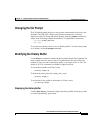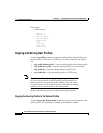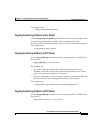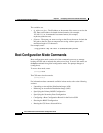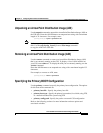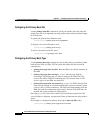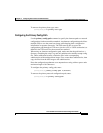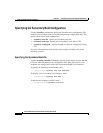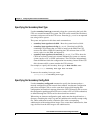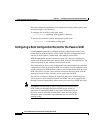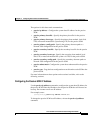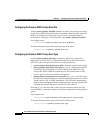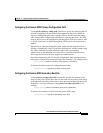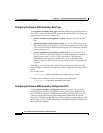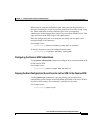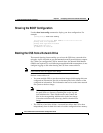
2-15
Cisco Content Services Switch Basic Configuration Guide
78-11424-03
Chapter 2 Configuring User Profiles and CSS Parameters
Boot Configuration Mode Commands
Specifying the Secondary Boot-Type
Use the secondary boot-type command to boot the system using the local disk,
FTP, or a network-mounted file system. The FTP record contains the IP address,
username, and password for the FTP server. Enter the ftp_record as an unquoted
text string with no spaces.
The syntax and options for this boot mode command are:
• secondary boot-type boot-via-disk - Boot the system from local disk.
• secondary boot-type boot-via-ftp ftp_record - Download an ADI file
containing CSS software that you want to install on the IDM. The CSS
accesses the ADI or GZIP file containing the CSS software from an FTP
server, copies it to the IDM, and unpacks it.
• secondary boot-type boot-via-network ftp_record - Use FTP to boot the
CSS from software located on a network-mounted file system on a remote
system (such as a PC or UNIX workstation). The CSS boots independently
from the IDM and loads the configuration into memory. Instead of the CSS
disk, the network file system contains the CSS software.
For example, to specify the secondary boot type as boot-via-disk, enter:
(config-boot)# secondary boot-type boot-via-disk
To remove the secondary boot type, enter:
(config-boot)# no secondary boot-type
Specifying the Secondary Config-Path
Use the secondary config-path command to specify the alternate path to a
network configuration for the network boot method. An alternate configuration
path allows multiple CSSs to use the same boot image while keeping their
configuration information in separate directories. The CSS must be able to access
the configuration path through an FTP server (such as a PC or UNIX workstation)
as defined through the FTP record for the network boot method.
When using an alternate configuration path, make sure that the path leads to a
directory containing the script, log, and info subdirectories and the startup-config
file. These subdirectories must contain the files in the corresponding
subdirectories of the unzipped boot image. First, create these subdirectories, then
copy the files from the boot image to the subdirectories.



